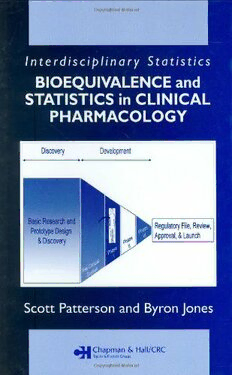
Bioequivalence and Statistics in Clinical Pharmacology (Interdisciplinary Statistics Series) PDF
384 Pages·2005·4.645 MB·English
Most books are stored in the elastic cloud where traffic is expensive. For this reason, we have a limit on daily download.
Preview Bioequivalence and Statistics in Clinical Pharmacology (Interdisciplinary Statistics Series)
Description:
Maintaining a practical perspective, Bioequivalence and Statistics in Clinical Pharmacology explores statistics used in day-to-day clinical pharmacology work. The book covers the methods needed to design, analyze, and interpret bioequivalence trials; explores when, how, and why these studies are performed as part of drug development; and demonstrates the proposed methods using real world examples. Drawing on knowledge gained directly from working in the pharmaceutical industry, the authors set the stage by describing the general role of statistics. Once the foundation of clinical pharmacology drug development, regulatory applications, and the design and analysis of bioequivalence trials are established, they move on to related topics in clinical pharmacology involving the use of cross-over designs. These include, but are not limited to, safety studies in Phase I, dose-response trials, drug interaction trials, food-effect and combination trials, QTc and other pharmacodynamic equivalence trials, and dose-proportionality trials. Purposefully designed to be instantly applicable, the book provides examples of SAS code so that the analysis described can be immediately implemented. The authors have made extensive use of the proc mixed procedures available in SAS.Each chapter includes a vignette based on co-author Scott Patterson's experience in the clinical pharmacology work place and all the data sets are taken from real trials. The authors delineate practical utility and objectives, provide real-world examples of the topic under discussion, and include statistical theory and applications. Technical theory, where extensive, is included in technical appendices at the end of the chapter. Each topic contains worked examples that illustrate the applications of the statistical techniques and their interpretation. The authors also develop statistical tools useful for other topics of clinical pharmacology - namely general safety testing, testing for proarrythmic potential, population pharmacokinetics, and dose-selection.
See more
The list of books you might like
Most books are stored in the elastic cloud where traffic is expensive. For this reason, we have a limit on daily download.
